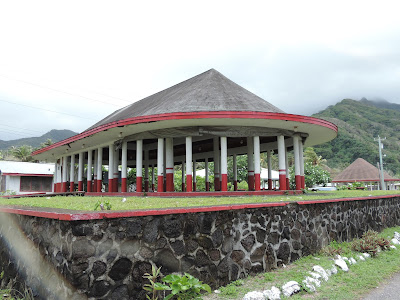Saturday, November 14, 2015
Welcome to American Samoa
“What's the latest gossip?” I ask my crew leader, Kim Kayano, biologist for the Department of Marine and Wildlife Resources of American Samoa. She's heard that we might be able to load supplies onto the Sili tomorrow and depart on it the next day. We've heard this rumor, or some version of it, about seven times in the past week, since arriving on Tutuila, American Samoa's main island. The Sili is a mysterious boat that brings semi-weekly supplies and travelers to the people living on the outlying Manua islands of Ta'u and Ofu-Olosega. The Sili has been in “dry dock” for repairs for over a month, and right as it was getting ready to dip its belly back into harbor, the local power company decided to charter the entire boat for their own purposes, with various promises to bring us, or our supplies, or just one truck and one human and no supplies, with them to Manua. We, meaning myself and my partner, Bobby Wilcox, are here on contract with Institute of Bird Populations to conduct a bird banding survey on Ofu-Olosega through the end of March. With the Sili's current reputation, we can't really afford to travel there without the stockpile of food we bought at Cost-U-Less that we hope will carry us through the very real potential of no resupply until we return in late March. We have learned quickly that frustration is futile; the only reasonable reaction is to laugh and say “sounds perfect.” After all, this particular Limbo offers ocean views and decent snorkeling, how can we complain? Not to mention, we are staying with a bat biologist who is currently taking care of two little orphans that enjoy papaya and belly rubs, and practice flying around their aviary (batiary?) at dusk. At least once a day, I think someone has thrown a basketball at the house, then I realize it was a falling coconut. There are certainly worse places to be indefinitely detained.
American Samoa is situated approximately halfway between Hawai'i and New Zealand, which is to say it's in the middle of effing nowhere on the big blue side of the Earth, along with a smattering of hundreds of other volcanic sneezes with high proportions of vowels in their names. The only flights to American Samoa launch from Honolulu or Apia, Samoa - what used to be called less ambiguously Western Samoa, the independent half of this 9-island archipelago, which also happens to be a significantly more important tourist destination, for infrastructural reasons that are becoming all too obvious. Heading southwest from Honolulu International Airport, I was pleasantly surprised to find myself a minority on the tin can that lofted us nearly to the date line – most people traveling to American Samoa are American Samoan. The main reason for this, and the lack of tourism, is that ninety percent of land here is communally owned by indigenous family dynasties and it is illegal to transfer ownership to anyone less than half-Samoan. How they managed to maintain this traditional system after becoming a US territory in 1900 is impressive and commendable, or close-minded and an obstacle to development, depending on who you ask. The National Park of American Samoa, part of the US National Park system, actually leases land in 50-year increments directly from its family owners, allowing subsistence agriculture and fishing within its boundaries. Bobby and I have yet to make it over to the area of the Park north of Pago Pago, partly for lack of transport but especially for fear that we may miss the fateful call that the Sili is loading for departure!
Subscribe to:
Post Comments (Atom)




Hi Kaitlin. Hope you well. We met at regua in Brazil. How you doing. Love to make contact and see how you. And bobby. Are doing?
ReplyDeleteWho are you, you didn't sign your name 😅
Delete